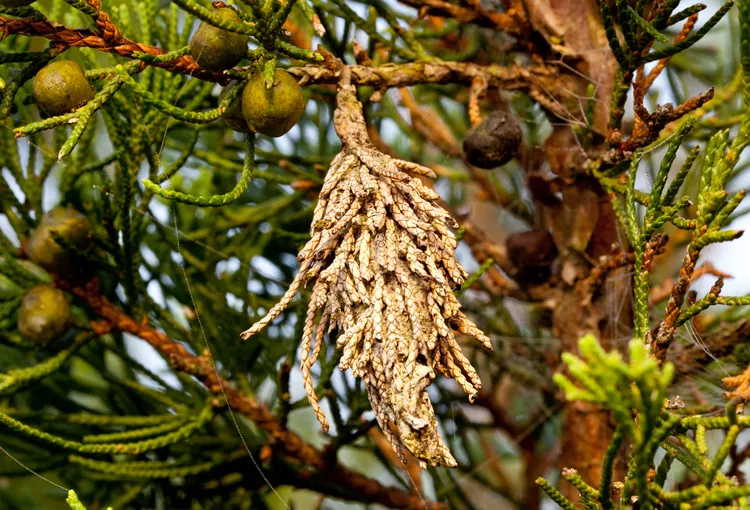Along with knowing how to get rid of bagworms, gardeners often need to know what they're even looking for because these garden pests have a unique camouflage. The first time I saw a bagworm infestation, I mistook the small brown bags hanging from an evergreen's branches for dead foliage. Little did I know then that each bag held a leaf-chewing caterpillar capable of decimating a tree or shrub if the infestation is big enough. Here's how to recognize and get rid of bagworms on your plants.
Laura Iles, Ph.D., is the director of Iowa State University's North Central Integrated Pest Management Center.
What do bagworms look like?
Bagworms are easy to miss at first. They start out as a small black caterpillar but soon they create a tough protective case, or bag, that protects them as they move around and feed. The bag is small at first, but as the larvae feed and grow, so do the bags in which they dwell.
Look for brownish, spindle-shaped bags, 1- to 2 inches long, which are fashioned by the caterpillars from silk and fragments of foliage, twigs, and bark from the host plant. Conical at first, diamond shaped later, they’re interwoven for strength and naturally colored for camouflage. When cut open, these sacks reveal the caterpillar, which can be anywhere from an eighth inch to 1 inch long, depending on the phase of its development.
Bagworm Life Cycle
Bagworms feed from the time they hatch in late spring/early summer until late summer. At that point, they seal their bags and transform into moths in preparation for mating.
“There is just one generation per summer,” explains Laura Iles, Ph.D., director of Iowa State University’s North Central Integrated Pest Management Center. The adult female remains in her bag while a winged male moth visits to mate. After laying 500 to 1,000 eggs, the female dies, but the eggs remain in her bag until hatching the following spring.
“Because the female cannot fly around and distribute her eggs in the landscape, most of her progeny will end up feeding on the same tree she did. This is why infestations build up over time,” Iles adds.
Plants That Bagworms Attack
Evergreen bagworms (one of the most damaging species) are native to North America and mainly found in the eastern U.S. and much of the Southeast. They attack more than 100 types of woody plants, primarily evergreens such as:
However, bagworms also will eat many deciduous plants, including:
Attacks on deciduous trees show up as small holes in leaves; on evergreens, branch tips turn brown and die. Deciduous plants often recover, but conifers do not regenerate new foliage to replace what has died, so a serious infestation can defoliate the canopy and kill the tree.
How to Get Rid of Bagworms
There are several ways to address bagworm infestations, depending on the severity. Hand-picking is an environmentally friendly method that is practical on mild infestations and those affecting smaller plants that are easier to reach. Serious attacks may call for other measures.
Mechanical Treatment
Use shears or a knife to cut bags off branches in late fall, winter, or early spring before eggs hatch in late May or early June. Burn or crush the bags, drop them in a bucket of soapy water or seal them in a plastic bag and toss in the trash. Do not leave them in the garden, as larvae may return to the host plant.
“Hand-picking is great for smaller plants and limited infestations,” says Iles, who provides educational training and diagnostic services related to home and garden insect pests for Iowa State University. “The eggs of the next generation are in the bags over the winter, so removal can really reduce or eliminate an infestation.”
Chemical Treatment
A pesticide spray may be more practical than hand-picking for very large infestations. Be sure to follow all label directions, and check before use that the insecticide is appropriate for the plant being treated (some insecticides can injure specific plants).
“The key is treating right when the young caterpillars first hatch from eggs in the bag and start feeding,” says Iles. This is typically from early to mid-June. “The caterpillar needs to consume the product in order to be killed. Younger caterpillars are more easily killed and this prevents more damage. Treating large caterpillars later in the season is not effective.” A follow-up treatment may be necessary if damage continues.
Natural Treatment
Apply insecticidal soaps or insecticides containing Bt (Bacillus thuringiensis var. kurstaki), neem oil, or spinosad in May or June when caterpillars are less than a half-inch long. Multiple applications may be needed. These natural formulations have less impact on beneficial insects that attack bagworms.
“Organic options such as Bt are very effective. Often, they are active for a short time so you want to be sure the caterpillars are present at the time of treatment and thoroughly cover the foliage,” Iles says.
Cultural Treatment
Parasitic wasps and tachinid flies feed on bagworm larvae. You can encourage their presence by avoiding chemical sprays. Also consider planting asters and daisies, which are especially good for attracting these beneficial insects when planted near vulnerable plants.
“Beneficial insects provide excellent control of bagworms,” Iles says, adding they will be attracted to a pollinator garden full of flowers that peak at different times of the season. Sparrows, finches, and other birds prey on bagworms as well, so encourage them to visit by planting fruit- and seed-bearing plants and offering a source of water.
When to Call an Arborist
The best option may be to enlist the services of a certified arborist. “I recommend working with an arborist when the infestation is extensive or on taller trees or conifers,” Iles says. “Arborists have the equipment needed to adequately treat larger trees.” It also saves the homeowner from having to store leftover chemicals.




















